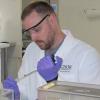Ichor Therapeutics has an ongoing study to repeat the Longecity sponsored pilot study we ran last year. Our sponsors have requested that we provide interim reporting to benefit the Longecity community, so current data will be provided in this post.
BACKGROUND
The extreme life extension in Winsar rats given c60oo reported by Baati et al is well known to the Life Extension community. A less well known aspect of the study is the effect of c60oo on age-related cancer incidence. Batti's control rats all showed evidence of tumors at necropsy, as is typical for rodents. Yet despite their advanced age, none of the treatment groups had tumors. Based on these findings, our group conducted a pilot study to directly assess the utility of c60oo as a treatment for human cancer using a xenograft leukemia model. We observed a dose-dependent increase in median lifespan, though these results were not conclusive because of limited sample size (n=5 per group).

In the present study, we propose to replicate and confirm our findings with a larger cohort. We also aim to assess c60oo biodistribution within C57BL/6 and NOD/SCID mouse strains, and compare these results with reports from Winsar rats to validate our model. Lastly, it is thought that c60oo may persist in the body for extended periods of time, so we will include time-points after c60oo administration has ceased to determine its long-term presence.
RESEARCH PLAN
The first objective of the present study is to assess the effect of c60oo administration on human leukemia proliferation in vivo using a modified version of the protocol described by Lehne et al. Briefly, immunocompromised mice will be inoculated with 1x107 Kg1a cells (human leukemia) by tail vein injection. After one week, mice will be treated with 8mg/kg c60oo or placebo every two days for six days, then once per week thereafter. Analytical endpoints will include complete blood counts and body mass. Additionally, a small cohort kept under identical conditions will be sacrificed 30 days post-inoculation to determine tumor burden by flow cytometric analysis of bone marrow aspirates. All procedures are routine to our laboratory.
The second objective of the present study is to determine c60oo biodistribution within standard C57BL/6 mice and the immunocompromised NOD/SCID strain. Briefly, mice will be treated by IP administration of 4mg/kg c60oo daily for 7 days and housed in metabolic cages. At days 1, 8, 30, and 90 mice (n=3) will be sacrificed and c60oo biodistribution within whole blood, liver, spleen, and brain will be quantified by HPLC analysis. These results will be compared to previous reports in Winsar rats to validate mice as a comparable model for current and future c60oo studies.
METHODS
HPLC
A PerkinElmer LC Flexar HPLC system, equipped with a UV/VIS detector and run with Chromera software was used for HPLC analysis (PerkinElmer, Inc. Waltham, Massachusetts, U.S). A reverse phase C18 column (4.6*150mm, 5um, Atlantis dc18, Waters Corp, US) was used for the entire HPLC analysis. A mixed solvent system of toluene and acetonitrile was used for the mobile phase, run isocratically with a composition of 70% toluene/30% acetonitrile with a flow rate of 0.5ml/min for a total run time of 15 minutes. Injection volumes were 20ul and the column was held at a constant temperature of 26 C.
Tissue extractions
10ul of internal standard (1mg/ml C70 in toluene) was placed into marked 15 ml falcon tubes and dried under a constant stream of air for 15 minutes. 100mg of liver and brain and 10mg of spleen were excised and placed into 1.7ml microcentrifuge tubes. 0.5ml 0.1M SDS solution was added to the pulverized tissue, and tissue samples were pulverized with glass rods until homogenous. The mixture was then transferred to the 15ml falcon tubes containing the dried internal standard. the original microcentrifuge tubes were rinsed with 0.5ml acetic acid and the rinsate was added to the same 15ml falcon tube as the tissue homogenate. samples were vortex mixed for 5 minutes. 3 ml of toluene were added and the mixture was agitated for 12 hours overnight in the dark at room temperature. Tubes were centrifuged for 10 minutes at 5000g and the top toluene layer was removed to a new 15ml falcon tube. Another 3 ml of toluene was added to the samples, which were agitated for 12 hours at room temperature in the dark once more. The centrifugation step was repeated and the toluene containing upper layer was removed and added to the same tube as the previous extraction. Supernatant was then dried down under a stream of warm air for 2 hours and the residue was dissolved in 500ul of mobile phase solution. 20ul of the sample was then injected into the HPLC.
Blood extractions
10ul of internal standard (1mg/ml C70 in toluene) was placed into marked 15 ml falcon tubes and dried under a constant stream of air for 15 minutes. 100ul of blood was placed into a 1.7ml microcentrifuge tube. 0.1ml 0.1M SDS solution was added and the mixture was then transferred to the 15ml falcon tubes containing the dried internal standard. the original microcentrifuge tubes were rinsed with 1ml acetic acid and the rinsate was added to the same 15ml falcon tube as the tissue homogenate. samples were vortex mixed for 5 minutes. 3 ml of toluene were added and the mixture was agitated for 12 hours overnight in the dark at room temperature. Tubes were centrifuged for 10 minutes at 5000g and the top toluene layer was removed to a new 15ml falcon tube. Another 3 ml of toluene was added to the samples, which were agitated for 12 hours at room temperature in the dark once more. The centrifugation step was repeated and the toluene containing upper layer was removed and added to the same tube as the previous extraction. Supernatant was then dried down under a stream of warm air for 2 hours and the residue was dissolved in 500ul of mobile phase solution. 20ul of the sample was then injected into the HPLC.
RESULTS
C60 was identified by HPLC and readily resolved from C70, the internal standard.

Concentrations of C60 in the blood, brain, liver, and spleen were quantified at D1 (group 1), D8 (group 2), and D30 (group 3). D90 data has not yet been collected.




During the pilot study, we failed to reliably quantify tumor burden by flow cytometry when analyzing Kg1a in peripheral mouse blood. In the present study, we modified our method to look in bone marrow instead. Kg1a populations clearly resolved at levels less than 1%.

A linearity test was performed comparing expected vs. actual Kg1a when mixed with bone marrow cells. The actual Kg1a measured was at lower levels than expected. This has been attributed to non-specificity in the FSC vs SSC gating. A viability dye was not included in the present assay, so a reliable all-cells gate could not be established. However, this assays appears to be valid as a relative measure of tumor burden.

Interestingly, tumor burden in the bone marrow of NOD/SCID mice (D30) was higher than that of olive oil or saline controls. This data cannot be fully evaluated in the absence of all-cause mortality data because multiple variables were changed since the pilot study. For example, the pilot study relied on in-house manufactured C60oo and CIEA NOG mice whereas the current study relied upon SES research C60oo and NOD/SCID mice.

Ichor is currently developing GMP grade analytical chemistry methods to fully evaluate C60oo quality and remove this variable from consideration. Death curves among the mice are expected to begin within 1-2 weeks. Data will be posted as it becomes available.























































